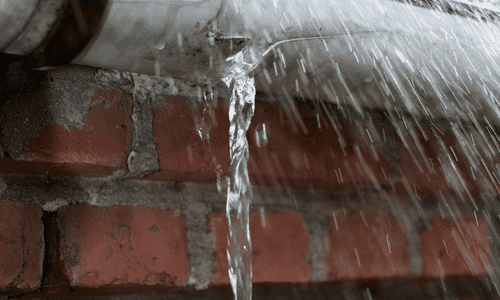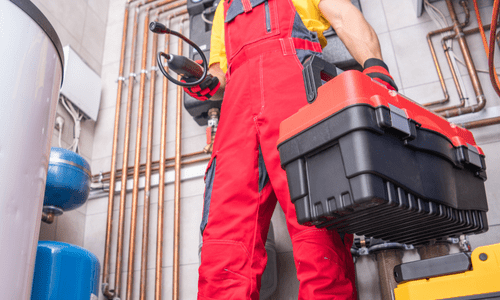No one wants to step into a puddle of water near their furnace. Furnace leaking water is quite common and should be dealt with immediately to ensure the continuity of your HVAC heating unit. The last thing you want is for your furnace to stop functioning right in the middle of those freezing winter months. And the first step toward fixing a leaking furnace is to know exactly why it’s leaking.
It takes professionals like River Valley to find permanent solutions to leaking furnaces. Get in touch with us today for unmatched HVAC solutions.
Why is my furnace leaking?

There are several reasons why your furnace might be leaking. To find out for sure, it is imperative to know the type of furnace you have at your home. There are two different furnace types your home can be fitted with – a conventional furnace or a high-efficiency furnace. If unsure, you should look for signs to determine the furnace type.
What kind of furnace do I have?
Even though both these furnaces achieve the same objective, there are some differences. The chief factors of consideration include the following.
Age of your home
Let’s face it. No modern home will have an older conventional-style furnace installed. If your home is relatively recent or you have moved into a new apartment, chances are you have a modern, high-efficiency furnace. For older homes, there are other signs to check.
AFUE rating
This indicates the Annual Fuel Utilization Efficiency (AFUE) of the furnace. In other words, it tells you the portion of the energy consumed to heat your home and the portion dissipated through chimneys, vents, and air leaks. Conventional furnaces will have an AFUE rating of 80%, while modern high-efficiency furnaces will have an efficiency rating of 90% or higher. This rating is printed on a yellow label on the unit itself.
Exhaust pipe
This is the most significant indicator that helps you determine your furnace type. As the name suggests, the exhaust pipe expels the exhaust smoke and heat from your furnace out of your home. If the exhaust pipe is made of metal, you have a conventional-type furnace. If, however, the pipe seems to be made of plastic-type material (PVC), this will indicate you have a modern, high-efficiency furnace.
Conventional furnace leaking

There are two main reasons why a conventional furnace may leak water. The first and most common is an issue with the built-in humidifier. The humidifier is responsible for emptying the excess water that builds up in your furnace through the drain line. If the drain line is clogged for any reason, the water can’t exit and instead starts leaking through the furnace.
A thorough check of the water lines that exit the humidifier can reveal the issue. In many cases, pinhole leaks and cracks are clearly visible. Another reason could be ill-fitted water lines that cause water to leak.
The next reason could be a loose or badly fitted exhaust pipe. However, a word of caution. Conventional exhaust pipes can get scorchingly hot and scald your skin on contact. If you don’t find any issues with the humidifier lines, it’s best not to proceed on your own.
High-efficiency furnace leaking
The first reason is similar to the previous entry, i.e., an issue with the condensate drain that expels excess liquid from your furnace. Any clogging of this drain will block the water from flowing out naturally and will instead start seeping through the furnace body. For small clogs, simply washing the line could suffice, but for larger clogs, you may have to get professional help.
The next reason may include an issue with the condensate pump. The pump is responsible for pushing the condensate out of the unit into the pipe. Older pumps can often malfunction and cause your modern high-efficiency furnace to leak. In such cases, repairing or replacing the pump may help.
AC leaking through the furnace
In several cases, your furnace may seem to leak, although you would only notice it when your room is being cooled by the AC. Issues with the AC’s condensate drain line can cause it to leak the excessive water it’s supposed to expel.
In many cases, an AC drain line can be near the furnace, making it seem as if the furnace is leaking. You can detect this by noticing whether or not the leakage appears only after switching the AC on. Therefore, your AC will need repair and not the furnace.
Can my furnace leak be fixed?
Of course, your furnace can be stopped from leakages. The good news is, in most cases, the reasons are quite simple and inexpensive. For all furnace types, if the drainage pipe is blocked, it can be easily cleaned off, and no further repair or replacement will be needed. However, rather than try to repair your furnace on your own, we recommend connecting with experts to ensure that your furnace leak is plugged in and keeps working for years to come.
The average cost of repairing your furnace is around $300. Although, replacing a furnace is substantially costlier and may cost around $4500 on average.
Despite this, it is highly recommended that you either repair or replace your furnace rather than suffer through the bruising winter months of waiting for an available repair team. If your unit continuously makes strange noises, your energy bills continue to increase, recent repairs or upgrades aren’t helping, or your unit is a decade and a half old, it might be time to get a replacement and stay warm and cozy through the winter months.
Selecting the right furnace repair team
If you are in a hurry to get your furnace repaired or replaced, simply don’t call up the first maintenance team you come across. We recommend that you do thorough research. Read online reviews, ask your neighbours, friends, or family, and then settle on a team. In any case, you can trust us for all your HVAC-related problems. We at River Valley pride ourselves on providing top-notch HVAC solutions in the tri-state area since 1995.
Remember that the right furnace repair team can ensure that your furnace keeps working for years at the minimum cost and service and help you stay covered across the winter.
